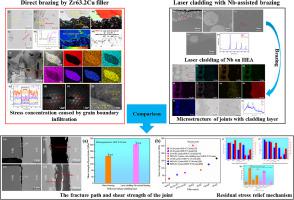当前位置:
X-MOL 学术
›
J. Mater. Sci. Technol.
›
论文详情
Our official English website, www.x-mol.net, welcomes your feedback! (Note: you will need to create a separate account there.)
Higher entropy-induced strengthening in mechanical property of Cantor alloys/Zr-3 joints by laser in-situ eutectic high-entropy transformation
Journal of Materials Science & Technology ( IF 11.2 ) Pub Date : 2024-06-13 , DOI: 10.1016/j.jmst.2024.04.083 Nan Jiang , Hong Bian , Xiaoguo Song , Hyeonseok Kwon , Xin Xi , Danyang Lin , Bo Chen , Weimin Long , Hyoung Seop Kim , Lianhui Jia
Journal of Materials Science & Technology ( IF 11.2 ) Pub Date : 2024-06-13 , DOI: 10.1016/j.jmst.2024.04.083 Nan Jiang , Hong Bian , Xiaoguo Song , Hyeonseok Kwon , Xin Xi , Danyang Lin , Bo Chen , Weimin Long , Hyoung Seop Kim , Lianhui Jia

|
To effectively regulate the grain boundary infiltration in CoCrFeMnNi high-entropy alloy (Cantor alloys, HEA) caused by the violent atomic interdiffusion, the higher configuration entropy on Cantor alloys surface was designed and realized via eutectic high-entropy (EHEA) transformation. Meanwhile, to effectively alleviate the residual stress caused by the notable difference in the thermal expansion coefficient (CTE) between Cantor alloys and Zr-3 alloys, a cladding layer was applied to the HEA surface using laser cladding technology of Nb, followed by brazing to Zr-3 alloys with Zr63.2Cu filler. The cladding layer's microstructure comprised Nbss and FCC+(Co,Ni)Nb eutectic structure, resulting from an in-situ reaction between Cantor alloys and Nb. The Nbss and FCC demonstrated good plasticity, and the (Co,Ni)Nb Laves phase provided increased strength, endowing both good plastic deformation ability and strength of the cladding layer. Notably, the existence of EHEA in the laser cladding layer made the Cantor alloy entropy from 1.61 R to 1.77 R, greatly enhancing its thermal stability and suppressing the grave grain boundary infiltration. Joints produced via laser cladding with Nb-assisted brazing exhibited a complex microstructure (HEA/Nbss + FCC + (Co,Ni)Nb/(Zr,Nb)(Cr,Mn) + (Zr,Nb)ss/(Zr,Nb)(Cu,Ni,Co,Fe) + (Zr,Nb)(Cr,Mn) + (Zr,Nb)ss/Zr-3 and a significantly improved shear strength of 242.8 MPa at 1010 °C for 10 min, 42.4 % higher than that of directly brazed joints. This improvement was attributed to reduced grain boundary infiltration, alleviated residual stress due to CTE disparity, and eliminated micro-cracks in the brazing seam. This study presents an effective solution for reducing residual stresses and achieving reliable bonding between Cantor alloys and Zr-3 alloys, with potential applications in brazing CoCrFeNi-based HEA and Zr-3 due to the beneficial eutectic reaction between CoCrFeNi and Nb.
中文翻译:

激光原位共晶高熵变高熵诱导强化Cantor合金/Zr-3接头力学性能
为了有效调节CoCrFeMnNi高熵合金(Cantor Alloys,HEA)中原子剧烈相互扩散引起的晶界浸润,通过共晶高熵(EHEA)转变设计并实现了Cantor合金表面较高的构型熵。同时,为有效缓解Cantor合金与Zr-3合金热膨胀系数(CTE)差异较大而产生的残余应力,采用Nb激光熔覆技术在HEA表面沉积一层熔覆层,然后钎焊至HEA表面。填充 Zr63.2Cu 的 Zr-3 合金。熔覆层的微观结构由Nbss和FCC+(Co,Ni)Nb共晶结构组成,是由康托合金和Nb之间的原位反应产生的。 Nbss和FCC表现出良好的塑性,(Co,Ni)Nb Laves相提供了增加的强度,赋予熔覆层良好的塑性变形能力和强度。值得注意的是,激光熔覆层中EHEA的存在使得康托合金的熵从1.61 R降至1.77 R,大大增强了其热稳定性并抑制了严重的晶界渗透。通过激光熔覆和铌辅助钎焊生产的接头表现出复杂的微观结构(HEA/Nbss + FCC + (Co,Ni)Nb/(Zr,Nb)(Cr,Mn) + (Zr,Nb)ss/(Zr,Nb) )(Cu,Ni,Co,Fe) + (Zr,Nb)(Cr,Mn) + (Zr,Nb)ss/Zr-3 并显着提高剪切强度,在 1010 °C 下 10 分钟为 242.8 MPa,42.4 % 高于直接钎焊接头,这种改进归因于减少了晶界渗透,减轻了 CTE 差异引起的残余应力,并消除了钎焊缝中的微裂纹。 这项研究提出了一种有效的解决方案,可减少残余应力并在 Cantor 合金和 Zr-3 合金之间实现可靠的结合,由于 CoCrFeNi 和 Nb 之间发生有益的共晶反应,因此在钎焊 CoCrFeNi 基 HEA 和 Zr-3 方面具有潜在的应用前景。
更新日期:2024-06-13
中文翻译:

激光原位共晶高熵变高熵诱导强化Cantor合金/Zr-3接头力学性能
为了有效调节CoCrFeMnNi高熵合金(Cantor Alloys,HEA)中原子剧烈相互扩散引起的晶界浸润,通过共晶高熵(EHEA)转变设计并实现了Cantor合金表面较高的构型熵。同时,为有效缓解Cantor合金与Zr-3合金热膨胀系数(CTE)差异较大而产生的残余应力,采用Nb激光熔覆技术在HEA表面沉积一层熔覆层,然后钎焊至HEA表面。填充 Zr63.2Cu 的 Zr-3 合金。熔覆层的微观结构由Nbss和FCC+(Co,Ni)Nb共晶结构组成,是由康托合金和Nb之间的原位反应产生的。 Nbss和FCC表现出良好的塑性,(Co,Ni)Nb Laves相提供了增加的强度,赋予熔覆层良好的塑性变形能力和强度。值得注意的是,激光熔覆层中EHEA的存在使得康托合金的熵从1.61 R降至1.77 R,大大增强了其热稳定性并抑制了严重的晶界渗透。通过激光熔覆和铌辅助钎焊生产的接头表现出复杂的微观结构(HEA/Nbss + FCC + (Co,Ni)Nb/(Zr,Nb)(Cr,Mn) + (Zr,Nb)ss/(Zr,Nb) )(Cu,Ni,Co,Fe) + (Zr,Nb)(Cr,Mn) + (Zr,Nb)ss/Zr-3 并显着提高剪切强度,在 1010 °C 下 10 分钟为 242.8 MPa,42.4 % 高于直接钎焊接头,这种改进归因于减少了晶界渗透,减轻了 CTE 差异引起的残余应力,并消除了钎焊缝中的微裂纹。 这项研究提出了一种有效的解决方案,可减少残余应力并在 Cantor 合金和 Zr-3 合金之间实现可靠的结合,由于 CoCrFeNi 和 Nb 之间发生有益的共晶反应,因此在钎焊 CoCrFeNi 基 HEA 和 Zr-3 方面具有潜在的应用前景。











































 京公网安备 11010802027423号
京公网安备 11010802027423号